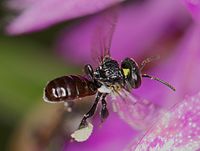
High thermal tolerance in high‐elevation species and laboratory‐reared colonies of tropical bumble bees
Sign Up to like & getrecommendations! Published in 2022 at "Ecology and Evolution"
DOI: 10.1002/ece3.9560
Abstract: Abstract Bumble bees are key pollinators with some species reared in captivity at a commercial scale, but with significant evidence of population declines and with alarming predictions of substantial impacts under climate change scenarios. While… read more here.
Keywords: elevation; thermal tolerance; laboratory reared; bumble bees ... See more keywords

Positive impact of postfire environment on bumble bees not explained by habitat variables in a remote forested ecosystem
Sign Up to like & getrecommendations! Published in 2023 at "Ecology and Evolution"
DOI: 10.1002/ece3.9743
Abstract: Abstract Bumble bees are important pollinators in temperate forested regions where fire is a driving force for habitat change, and thus understanding how these insects respond to fire is critical. Previous work has shown bees… read more here.
Keywords: positive impact; bumble bees; postfire environment; fire ... See more keywords

Disease where you dine: plant species and floral traits associated with pathogen transmission in bumble bees.
Sign Up to like & getrecommendations! Published in 2018 at "Ecology"
DOI: 10.1002/ecy.2503
Abstract: Hotspots of disease transmission can strongly influence pathogen spread. Bee pathogens may be transmitted via shared floral use, but the role of plant species and floral trait variation in shaping transmission dynamics is almost entirely… read more here.
Keywords: plant; transmission; floral traits; plant species ... See more keywords

Limitation of complementary resources affects colony growth, foraging behavior, and reproduction in bumble bees.
Sign Up to like & getrecommendations! Published in 2019 at "Ecology"
DOI: 10.1002/ecy.2946
Abstract: Resource availability has been disturbed for many organisms in agricultural landscapes including pollinator species. Abundance and diversity in flower availability benefit bee populations, however, little is known about which of protein or carbohydrate resources may… read more here.
Keywords: reproductive performance; pollen; supplemental feeding; bumble bees ... See more keywords

Contrasting patterns of richness, abundance, and turnover in mountain bumble bees and their floral hosts.
Sign Up to like & getrecommendations! Published in 2022 at "Ecology"
DOI: 10.1002/ecy.3712
Abstract: Environmental gradients generate and maintain biodiversity on Earth. Mountain slopes are among the most pronounced terrestrial environmental gradients, and the elevational structure of species and their interactions can provide unique insight into the processes that… read more here.
Keywords: diversity; elevation; mountain; abundance ... See more keywords

Bumble bee use of post‐fire chaparral in the central Sierra Nevada
Sign Up to like & getrecommendations! Published in 2017 at "Journal of Wildlife Management"
DOI: 10.1002/jwmg.21280
Abstract: Bumble bees (Bombus spp.) are declining across many regions in the Northern Hemisphere, leading to a need for management actions that will protect and enhance their habitats. In the Sierra Nevada of California, USA, montane… read more here.
Keywords: bumble bees; bee; bumble bee; post fire ... See more keywords

Synergistic interactions between a variety of insecticides and an ergosterol biosynthesis inhibitor fungicide in dietary exposures of bumble bees (Bombus terrestris L.).
Sign Up to like & getrecommendations! Published in 2018 at "Pest management science"
DOI: 10.1002/ps.4756
Abstract: BACKGROUND In recent years, concern has been raised over honey bee colony losses, and also among wild bees there is evidence for extinctions and range contractions in Europe and North America. Pesticides have been proposed… read more here.
Keywords: ergosterol biosynthesis; bombus terrestris; toxicity; biosynthesis inhibitor ... See more keywords

Effect of flower perceptibility on spatial-reward associative learning by bumble bees
Sign Up to like & getrecommendations! Published in 2017 at "Behavioral Ecology and Sociobiology"
DOI: 10.1007/s00265-017-2328-y
Abstract: The associative learning of spatial and reward information is generally considered an adaptive behavior of foraging animals that collect food from renewable resources. However, learning may not always maximize foraging efficiency if choosing a high-reward… read more here.
Keywords: effect; spatial reward; associative learning; reward ... See more keywords

Investigating the Foraging, Guarding and Drifting Behaviors of Commercial Bombus terrestris
Sign Up to like & getrecommendations! Published in 2021 at "Journal of Insect Behavior"
DOI: 10.1007/s10905-021-09790-0
Abstract: Social insects have high levels of cooperation and division of labor. In bumble bees this is partly size-based, with larger bees performing tasks outside the nest and smaller bees remaining inside, although bumble bees still… read more here.
Keywords: bombus terrestris; foraging guarding; bumble bees; division labor ... See more keywords

Bumble bees show an induced preference for flowers when primed with caffeinated nectar and a target floral odor
Sign Up to like & getrecommendations! Published in 2021 at "Current Biology"
DOI: 10.1016/j.cub.2021.06.068
Abstract: Caffeine is a widely occurring plant defense chemical1,2 that occurs in the nectar of some plants, e.g., Coffea or Citrus spp., where it may influence pollinator behavior to enhance pollination.3,4 Honey bees fed caffeine form… read more here.
Keywords: caffeinated nectar; target; floral odor; bumble bees ... See more keywords

Evaluating the molecular, physiological and behavioral impacts of CO2 narcosis in bumble bees (Bombus impatiens).
Sign Up to like & getrecommendations! Published in 2017 at "Journal of insect physiology"
DOI: 10.1016/j.jinsphys.2017.06.014
Abstract: Exposure to carbon dioxide (CO2) has pleiotropic effects in many insect species, ranging from eliciting rapid behavioral responses such as attraction, to dramatic physiological changes, including ovary activation. In bumble bees, CO2 narcosis causes queens… read more here.
Keywords: bombus impatiens; co2 narcosis; bumble bees; physiology ... See more keywords